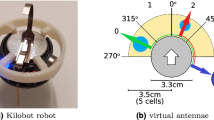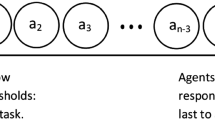Abstract
This paper proposes a novel method for autonomous role assignment and task allocation using the response threshold model through local interactions in scalable swarm robotic systems. The response threshold describes sensitivity for pheromones of ants. In reality, there are high and low pheromone sensitivity ants. It is known that the pheromone sensitivity of ants is related to autonomous role assignment and task allocation. In conventional response threshold models, it is assumed that an ant can gain the number of all the workers in an ant colony. However, it is difficult for an ant to gain and deal with all the workers, because ant functions are very limited. Thus, we use a response threshold model that refers to the number of encountered foraging ants instead of the number of all the workers. In this study, we apply the proposed method to ant foraging problems and show the robustness of the proposed method in dynamic environments.








Similar content being viewed by others
Explore related subjects
Discover the latest articles, news and stories from top researchers in related subjects.References
Nolfi S, Floreano D (2000) Evolutionary robotics: the biology, intelligence, and technology of self-organizing machines. MIT Press, Cambridge
Bloembergen D, Tuyls K, Hennes D, Kaisers M (2015) Evolutionary dynamics of multi-agent learning: a survey. J Artif Intell Res 53:659–697
Navarro I, Matía F (2013) An Introduction to Swarm Robotics, ISRN Robotics, Vol.2013, Article ID 608164
Dorigo M, Stutzle T (2004) Ant Colony Optimization. MIT Press, Cambridge
Miller P (2010) The Smart Swarm. Avery, Glendale
Bonabeau E, Sobkowski A, Theraulaz G, Deneubourg JL (1997) Adaptive task allocation inspired by a model of division of labor in social insects. In: Proceedings of BCEC97, pp.36-45
Hasegawa E, Ishii Y, Tada K, Kobayashi K, Yoshimura J (2016) Lazy workers are necessary for long-term sustainability in insect societies. Sci Rep 6:20846
Nakayama K, Sueoka Y, Ishikawa M, Sugimoto Y, Osuka K (2014) Control of transportation trails by distributed autonomous agents inspired by the foraging behavior of ants. Nonlinear Theory Appl 5(4):487–498
Ogihara Y, Yamanaka O, Akino T, Izumi S, Awazu A, Nishimori H (2015) Switching of primarily relied information by ants: a combinatorial study of experiment and modeling, mathematical approaches to biological systems: networks. oscillations and collective motions. Springer, heidelberg, pp119–137
Yamada K (2016) Specialization in Swarm Robotics using local interactions. Int J Eng Res Technol 5(10):103–108
Fujisawa R, Imamura H, Hashimoto T, Matsuno F (2008) Communication using pheromone field for multiple robots. In: Proceedings of IEEE/RSJ 2008 international conference on intelligent robots and systems (IROS2008), pp.1391-1396
Iwai T, Wakamiya N, Murata M (2012) Response threshold model-based device assignment for cooperative resource sharing in a WSAN. IN: International journal of swarm intelligence and evolutionary computation, Vol.1, April
Acknowledgements
This research was supported by JSPS KAKENHI Grant number JP 18K11554.
Author information
Authors and Affiliations
Corresponding author
Additional information
This work was presented in part at the 2nd International Symposium on Swarm Behavior and Bio-Inspired Robotics, Kyoto, October 29–November 1, 2017.
About this article
Cite this article
Yamada, K. Autonomous role assignment and task allocation in scalable swarm robotic systems using local interactions. Artif Life Robotics 23, 636–644 (2018). https://doi.org/10.1007/s10015-018-0500-8
Received:
Accepted:
Published:
Issue Date:
DOI: https://doi.org/10.1007/s10015-018-0500-8




